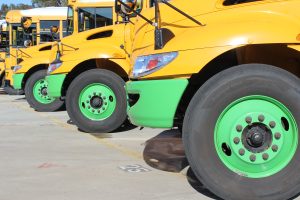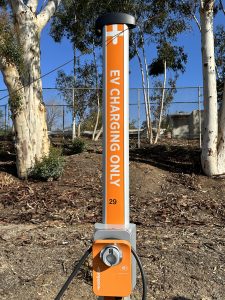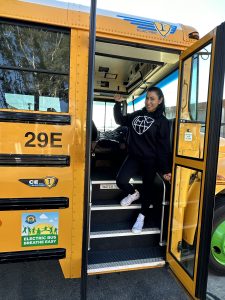Cleaner, Quieter School Buses Power La Mesa-Spring Valley Schools
Investments in electric buses pay off for students, staff, and the community

The La Mesa-Spring Valley school district is continuing its ongoing investment in electric vehicles for its school bus fleet, with great results all around. From reducing pollution inside and outside the buses to saving costs on fuel, the program delivers benefits to students and drivers in addition to the district’s finances. LMSV first introduced electric buses in 2022 and they currently have a fleet of nine that serve four routes.
Ryan Brewer, the Director of Transportation for the district explains: “Three of the nine buses are smaller for specialized units like Special Ed, while the other six are larger, 72-student seaters designed for General Education. Right now, two of our Special Ed units are used every day as are four of our large buses.”
Brewer says diesel buses are still used for one route because it’s mostly used for field trips, which benefit from the 84-passenger capacity of diesel buses. Also, the current charge for electric buses is in the 80-100 mile range, and field trips can be further than this.

All of the district’s nine buses were obtained by an EPA CEC grant, which also provided money for the infrastructure for charging. “When we initially installed everything, we went very conservative and got small chargers that were being charged at tiers that are more expensive,” explains Brewer.
He’s currently working to cut costs by upgrading chargers so buses can be charged faster during the short non-peak hour window when electricity fees are lower. Once this is achieved, Brewer’s next goal will be to get an additional grant for more buses.
As part of the current grant, the district provides quarterly reports that include data on electricity usage so this can be compared to diesel costs and determine the savings.
A report by the Environmental Defense Fund found that the total cost of ownership over the lifetime for a diesel school bus was $653,000, compared to $410,000 for an electric one.
The Human Factor

While finances are a tangible benefit from the change from diesel to electric, there are health and social-emotional benefits as well.
Zulema Brooks has been a bus driver with the La Mesa-Spring Valley School District for ten years and sums up the EPA’s findings perfectly: “The electric buses are awesome and the biggest benefit is that there’s no smell. There are no exhaust fumes. The kids are breathing cleaner air. We are breathing cleaner air, and everyone else around us is as well.
“I also love driving them because they’re so quiet,” she continues. “I can hear everything so I can focus on the kids’ needs and what they’re saying and doing.”
Brooks says parents were a little apprehensive due to the quietness because of safety concerns in case children didn’t hear the buses approaching. “But even the parents adjusted just fine,” she says. “I think we’re all loving it.”
Fellow bus driver Maryann Comilang has been with the district for five years but she’s been a bus driver since 1993.
“I don’t smell like diesel anymore,” she smiles. “And the kids, myself, and any staff on the bus aren’t exposed to the fumes or bad chemicals. It’s quite amazing, and after like, day two, I couldn’t see myself going back to a regular diesel bus.
“I feel the kids really enjoy the fact that there’s very little noise, and I don’t have to try to figure out what’s going on in the back. I can almost hear a dime drop back there. It’s such a smooth ride.”
Health Benefits of Electric Buses
A report by the Environmental Defense Fund states that EV buses reduce greenhouse emissions by almost 70% over their lifetime, while research by the Scientific American concluded that ‘Pollution levels inside those iconic yellow buses can be up to 10 times higher than outside’.
In addition, the Environmental Protection Agency (EPA) says that because electric buses are the only zero tailpipe pollution option on the market, ‘students, drivers, and members of the community will be exposed to significantly less harmful diesel emissions like PM and NOX’..’ by using them.
The Relational Impact Of Drivers

For drivers like Brooks and Comilang, driving the bus is an expression of their care and concern for the students they see every day. Illustrating the importance her role – which she describes as ‘giving back the world’ – is, Comilang says, “it’s more than just driving a bus. You interact with children and you try to make a difference in their life, even if it’s just for a short moment.
“We’re the first person they see to start their school day when they get on that bus. We’re able to turn their behaviors around with just a little chit-chat and get them started on a good footing before they get off the bus and go to school. I absolutely love what I do.”

